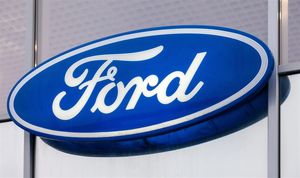
Heating, ventilation, air conditioning, and refrigeration company Carrier Global (NYSE: CARR) met Wall Street’s revenue expectations in Q3 CY2025, but sales fell by 6.8% year on year to $5.58 billion. The company’s full-year revenue guidance of $22.5 billion at the midpoint came in 1.4% above analysts’ estimates. Its non-GAAP profit of $0.67 per share was 17.7% above analysts’ consensus estimates.
Is now the time to buy CARR? Find out in our full research report (it’s free for active Edge members).
Carrier Global (CARR) Q3 CY2025 Highlights:
- Revenue: $5.58 billion vs analyst estimates of $5.56 billion (6.8% year-on-year decline, in line)
- Adjusted EPS: $0.67 vs analyst estimates of $0.57 (17.7% beat)
- Adjusted EBITDA: $1.09 billion vs analyst estimates of $1.03 billion (19.6% margin, 6.3% beat)
- The company dropped its revenue guidance for the full year to $22.5 billion at the midpoint from $23 billion, a 2.2% decrease
- Management lowered its full-year Adjusted EPS guidance to $2.65 at the midpoint, a 13.1% decrease
- Operating Margin: 9.7%, down from 12.8% in the same quarter last year
- Organic Revenue fell 4% year on year vs analyst estimates of 5.3% declines (126.3 basis point beat)
- Market Capitalization: $49.99 billion
StockStory’s Take
Carrier Global’s third quarter was shaped by significant softness in North American residential sales and continued declines in the European heating market, which management indicated drove much of the year-over-year revenue and margin reduction. CEO David Gitlin cited “about a $500 million sales challenge and a $0.20 to $0.25 adjusted EPS headwind” tied to residential, but noted that better-than-expected performance in Commercial HVAC in the Americas and ongoing aftermarket growth helped partially offset these pressures. Cost containment initiatives and targeted headcount reductions were also implemented to mitigate the impact of lower volumes.
Looking ahead, Carrier’s updated guidance reflects continued caution on the residential and European heating segments, with management focusing on aggressive inventory reductions and structural cost takeout. Gitlin emphasized that “field inventory levels ending this year will be down 30% year-over-year” and expects these actions, combined with ongoing investments in digital platforms and commercial HVAC capacity, to position the company for improved performance as market conditions stabilize. Management also highlighted the importance of maintaining pricing discipline and leveraging data center demand as key pillars for navigating the uncertain macroeconomic environment.
Key Insights from Management’s Remarks
Management attributed the quarter’s results to pronounced declines in residential demand, balanced by strong momentum in commercial HVAC and aftermarket services, as well as cost-reduction actions.
- Residential sales decline: North American residential HVAC sales fell sharply, with volume down about 40%, as both end-market demand and channel destocking weighed on results. Management reported field inventories down 12% year-over-year at quarter-end, with aggressive actions to reach 30% reductions by year-end.
- Commercial HVAC outperformance: The Americas commercial HVAC business grew 30%, driven by strong data center orders and robust applied equipment sales. Data center segment sales are on pace to double this year, with backlog expected to support further growth in 2026.
- Aftermarket business resilience: Aftermarket sales rose 12%, marking the fifth consecutive year of double-digit growth. Digital offerings like Abound and Lynx saw increased adoption, with Lynx subscriptions up 40% to 210,000, highlighting the company’s focus on recurring revenue streams.
- Cost containment and restructuring: Carrier implemented structural cost reductions, including the elimination of about 3,000 indirect positions globally. CFO Patrick Goris confirmed these actions are designed to deliver ongoing savings, not just temporary expense cuts, leveraging automation and digital tools.
- European heat pump momentum: Despite overall market weakness, European residential heat pump sales rose 15%, and German heat pump sales climbed 45%. Management is positioning for longer-term growth as electrification gains traction and regulatory tailwinds strengthen.
Drivers of Future Performance
Carrier’s outlook is anchored by ongoing commercial HVAC strength, structural cost actions, and a cautious stance on residential and European heating recovery.
- Commercial growth supports recovery: The commercial HVAC segment, especially in the Americas, is expected to remain a major growth driver. Management projects continued demand from data center customers, with a backlog extending into 2028 and a strong pipeline for applied equipment and aftermarket services.
- Structural cost savings: Aggressive cost reduction efforts—including headcount cuts and increased automation—are forecast to yield more than $100 million in carryover savings next year. Management expects these measures to provide about $0.20 of adjusted EPS tailwind in 2026, independent of organic growth.
- Residential and European market uncertainty: Management remains cautious on residential and European heating markets, with destocking efforts expected to conclude by year-end. While field inventories should bottom at multi-year lows, CEO Gitlin warned that demand visibility remains limited and that the company is planning conservatively for low single-digit organic growth in 2026.
Catalysts in Upcoming Quarters
Heading into future quarters, our analysts will closely watch (1) the pace and effectiveness of residential inventory destocking and corresponding demand stabilization, (2) whether commercial HVAC, particularly data center-related business, can sustain its current growth trajectory, and (3) the realization of structural cost savings as operational changes take effect. Monitoring the adoption of digital platforms and the recovery of European and Chinese markets will also be important for assessing Carrier’s ability to rebound from recent softness.
Carrier Global currently trades at $58.92, up from $58.27 just before the earnings. In the wake of this quarter, is it a buy or sell? The answer lies in our full research report (it’s free for active Edge members).
High Quality Stocks for All Market Conditions
Trump’s April 2025 tariff bombshell triggered a massive market selloff, but stocks have since staged an impressive recovery, leaving those who panic sold on the sidelines.
Take advantage of the rebound by checking out our Top 5 Strong Momentum Stocks for this week. This is a curated list of our High Quality stocks that have generated a market-beating return of 183% over the last five years (as of March 31st 2025).
Stocks that made our list in 2020 include now familiar names such as Nvidia (+1,545% between March 2020 and March 2025) as well as under-the-radar businesses like the once-small-cap company Exlservice (+354% five-year return). Find your next big winner with StockStory today.
StockStory is growing and hiring equity analyst and marketing roles. Are you a 0 to 1 builder passionate about the markets and AI? See the open roles here.





